Fiber Bragg Grating Dynamic Calibration Based on Online Sequential Extreme Learning Machine
Abstract
1. Introduction
2. Methods and Experiment Setup
2.1. Extreme Learning Machine
2.2. OS-ELM
2.3. Experiment Setup
3. Results and Discussion
3.1. Data Set
3.2. Simulated Analysis
3.3. Dynamic Calibration
4. Discussion
Author Contributions
Funding
Conflicts of Interest
References
- Ma, S.; Guo, J.; Guo, L.; Cao, J.; Zhang, B. On-line monitoring system for downhole temperature and pressure. Opt. Eng. 2014, 8, 087102. [Google Scholar]
- Antunes, P.; Travanca, R.; Rodrigues, H.; Melo, J.; Jara, J.; Varum, H.; Andre, P. Dynamic structural health monitoring of slender structures using optical sensors. Sensors 2012, 5, 6629–6644. [Google Scholar] [CrossRef]
- Mohanty, L.; Tjin, S.C.; Lie, D.T.T.; Panganiban, S.E.C.; Chow, P.K.H. Fiber grating sensor for pressure mapping during total knee arthroplasty. Sens. Actuators A Phys. 2007, 2, 323–328. [Google Scholar] [CrossRef]
- Xiong, L.; Jiang, G.; Guo, Y.; Liu, H. A Three-dimensional Fiber Bragg Grating Force Sensor for Robot. IEEE Sens. J. 2018, 9, 3632–3639. [Google Scholar] [CrossRef]
- Huang, F.; Chen, T.; Si, J.; Pham, X.; Hou, X. Fiber laser based on a fiber Bragg grating and its application in high-temperature sensing. Opt. Commun. 2019, 452, 233–237. [Google Scholar] [CrossRef]
- Hong, C.; Zhang, Y.; Zhang, M.; Gordon, L.L.M.; Liu, L. Application of FBG sensor for geotechnical health monitoring, a review of sensor design, implementation methods and packaging techniques. Sens. Actuators A Phys. 2016, 244, 184–197. [Google Scholar] [CrossRef]
- Zhang, X.; Wang, P.; Liang, D.; Fan, C.; Li, C. A soft self-repairing for FBG sensor network in SHM system based on PSO–SVR model reconstruction. Opt. Commun. 2015, 343, 38–46. [Google Scholar] [CrossRef]
- Lamberti, A.; Chiesura, G.; Luyckx, G.; Degrieck, J.; Kaufmann, M.; Vanlanduit, S. Dynamic strain measurements on automotive and aeronautic composite components by means of embedded fiber Bragg grating sensors. Sensors 2015, 10, 27174–27200. [Google Scholar] [CrossRef]
- Marignetti, F.; de Santis, E.; Avino, S.; Tomassi, G.; Giorgini, A.; Malara, P.; De Natale, P.; Gagliardi, G. Fiber bragg grating sensor for electric field measurement in the end windings of high-voltage electric machines. IEEE Trans. Ind. Electron. 2016, 5, 2796–2802. [Google Scholar] [CrossRef]
- Dziuda, L.; Skibniewski, F.W.; Krej, M.; Lewandowski, J. Monitoring respiration and cardiac activity using fiber Bragg grating-based sensors. IEEE Trans. Biomed. Eng. 2012, 7, 1934–1942. [Google Scholar] [CrossRef]
- Domingues, F.; Alberto, N.; Leitão, C.; Tavares, C.; Lima, E.; Radwan, A.; Sucasas, V.; Rodriguez, J.; André, P.; Antunes, P. Insole optical fiber sensor architecture for remote gait analysis-an eHealth Solution. IEEE Internet Things J. 2017, 6, 207–214. [Google Scholar] [CrossRef]
- Okabe, Y.; Tsuji, R.; Takeda, N. Application of chirped fiber Bragg grating sensors for identification of crack locations in composites. Compos. Part A Appl. Sci. 2003, 1, 59–65. [Google Scholar] [CrossRef]
- Reid, M.B.; Ozcan, M. Temperature dependence of fiber optic Bragg gratings at low temperatures. Opt. Eng. 1998, 1, 237–242. [Google Scholar] [CrossRef]
- Roths, J.; Andrejevic, G.; Kuttler, R.; Süßer, M. Calibration of fiber Bragg cryogenic temperature sensors. In International Optical Fiber Sensors Conference; OSA: Washington, DC, USA, 2006; pp. 81–85. [Google Scholar]
- Saccomanno, A.; Breglio, G.; Irace, A.; Bajko, M.; Szillasi, Z.; Buontempo, S.; Giordano, M.; Cusano, A. A calibration method based on look-up-table for cryogenic temperature Fiber Bragg Grating sensors. In Proceedings of the 3rd Asia Pacific Optical Sensors Conference, Sydney, Australia, 31 January–3 February 2012; pp. 83513–83515. [Google Scholar]
- An, Y.; Wang, X.; Qu, Z.; Liao, T.; Nan, Z. Fiber Bragg grating temperature calibration based on BP neural network. Optik 2018, 172, 753–759. [Google Scholar] [CrossRef]
- An, Y.; Wang, X.; Qu, Z.; Liao, T.; Wu, L.; Nan, Z. Stable temperature calibration method of fiber Bragg grating based on radial basis function neural network. Opt. Eng. 2019, 9, 096105. [Google Scholar] [CrossRef]
- Jiang, J.; Zang, C.; Wang, Y.; Zhang, X.; Liu, Y.; Yang, Y.; Xie, R.; Fan, X.; Liu, T. Investigation of composite multi—Wavelength reference stabilization method for FBG demodulator in unsteady temperature environment. J. Optoelectron. Laser 2018, 6, 5–11. [Google Scholar]
- Xie, R.; Zhang, X.; Wang, S.; Jiang, J.; Liu, K.; Zang, C.; Chu, Q.; Liu, T. Research on influencing factors of FBG temperature sensors stability. J. Optoelectron. Laser 2018, 4, 363–369. [Google Scholar]
- Huang, G.; Zhu, Q.; Siew, C. Extreme learning machine: Theory and applications. Neurocomputing 2006, 1, 489–501. [Google Scholar] [CrossRef]
- Rong, H.; Huang, G.; Sundararajan, N.; Saratchandran, P. Online Sequential Fuzzy Extreme Learning Machine for Function Approximation and Classification Problems. IEEE Trans. Syst. Man Cybern. B 2009, 4, 1067–1072. [Google Scholar] [CrossRef]
- Li, Z.; Fan, X.; Chen, G.; Yang, G.; Sun, Y. Optimization of iron ore sintering process based on ELM model and multi-criteria evaluation. Neural Comput. Appl. 2017, 8, 2247–2253. [Google Scholar] [CrossRef]
- Lu, F.; Wu, J.; Huang, J.; Qiu, X. Aircraft engine degradation prognostics based on logistic regression and novel OS-ELM algorithm. Aerosp. Sci. Technol. 2018, 84, 661–671. [Google Scholar] [CrossRef]
- Wang, X.; Yang, K.; Kalivas, J.H. Comparison of extreme learning machine models for gasoline octane number forecasting by near-infrared spectra analysis. Optik 2020, 200, 163325. [Google Scholar] [CrossRef]
- Liang, N.; Huang, G.; Saratchandran, P.; Sundararajan, N. A Fast and accurate online sequential learning algorithm for feedforward networks. IEEE Trans. Neural Netw. 2006, 6, 1411–1423. [Google Scholar] [CrossRef]

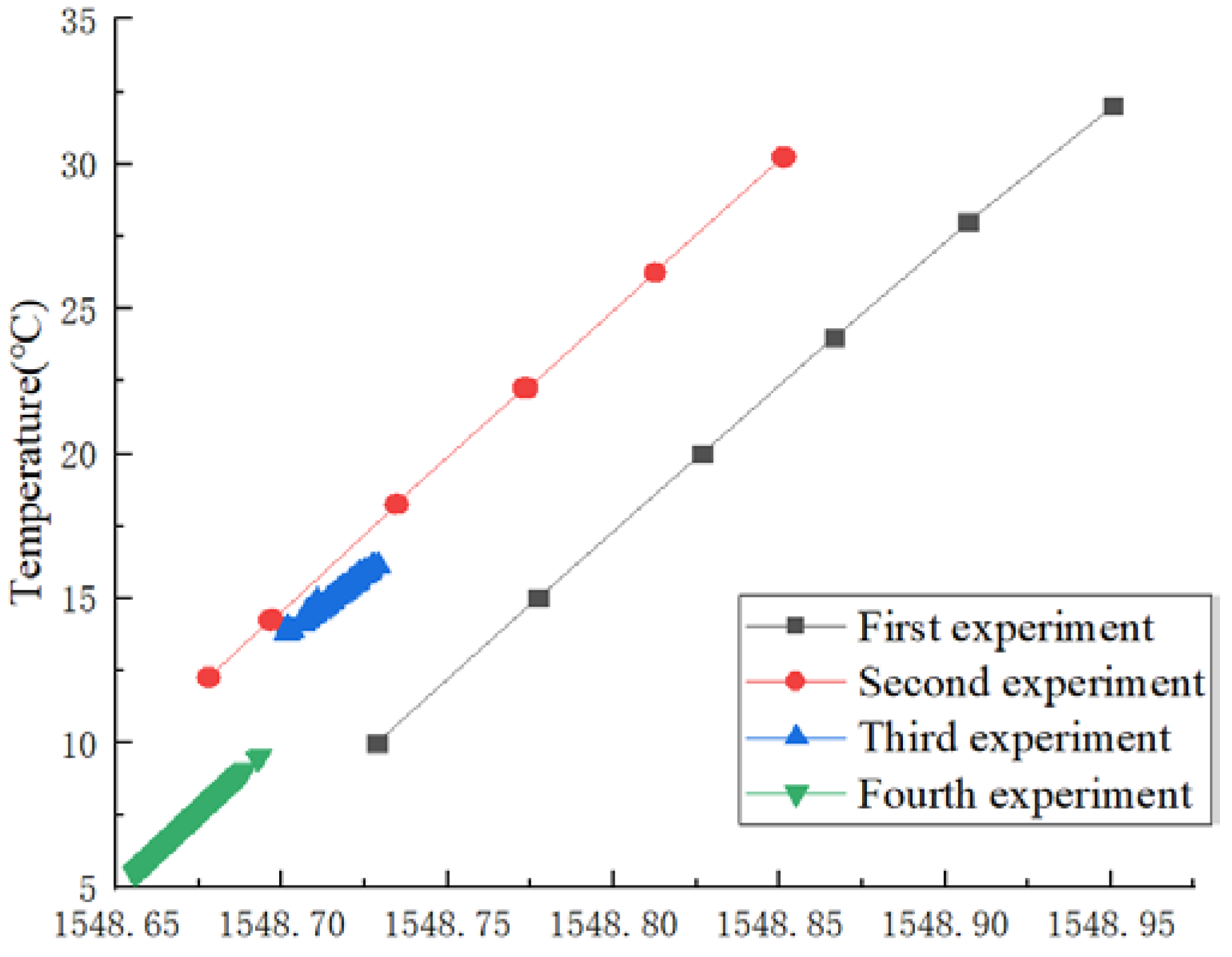

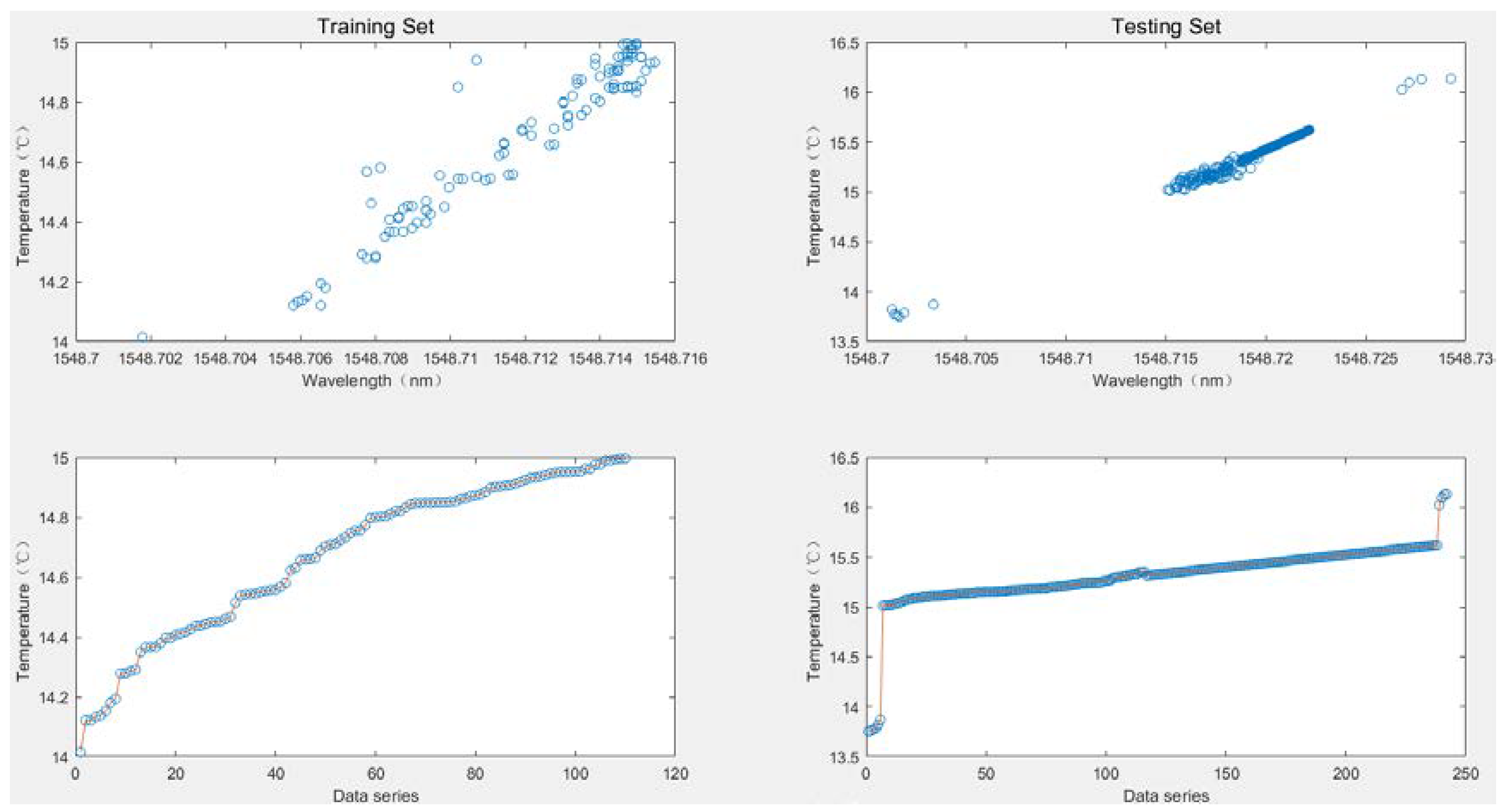

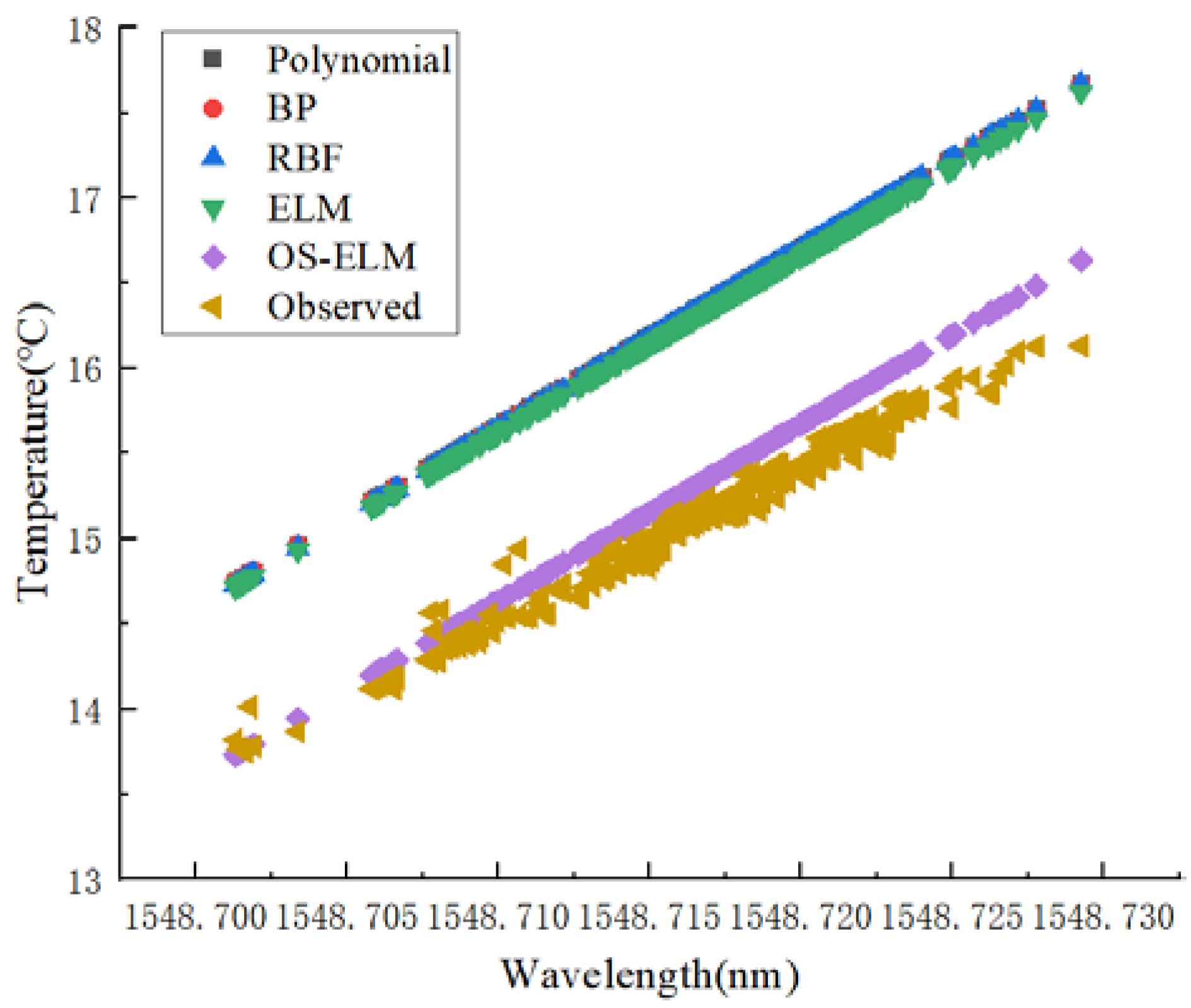
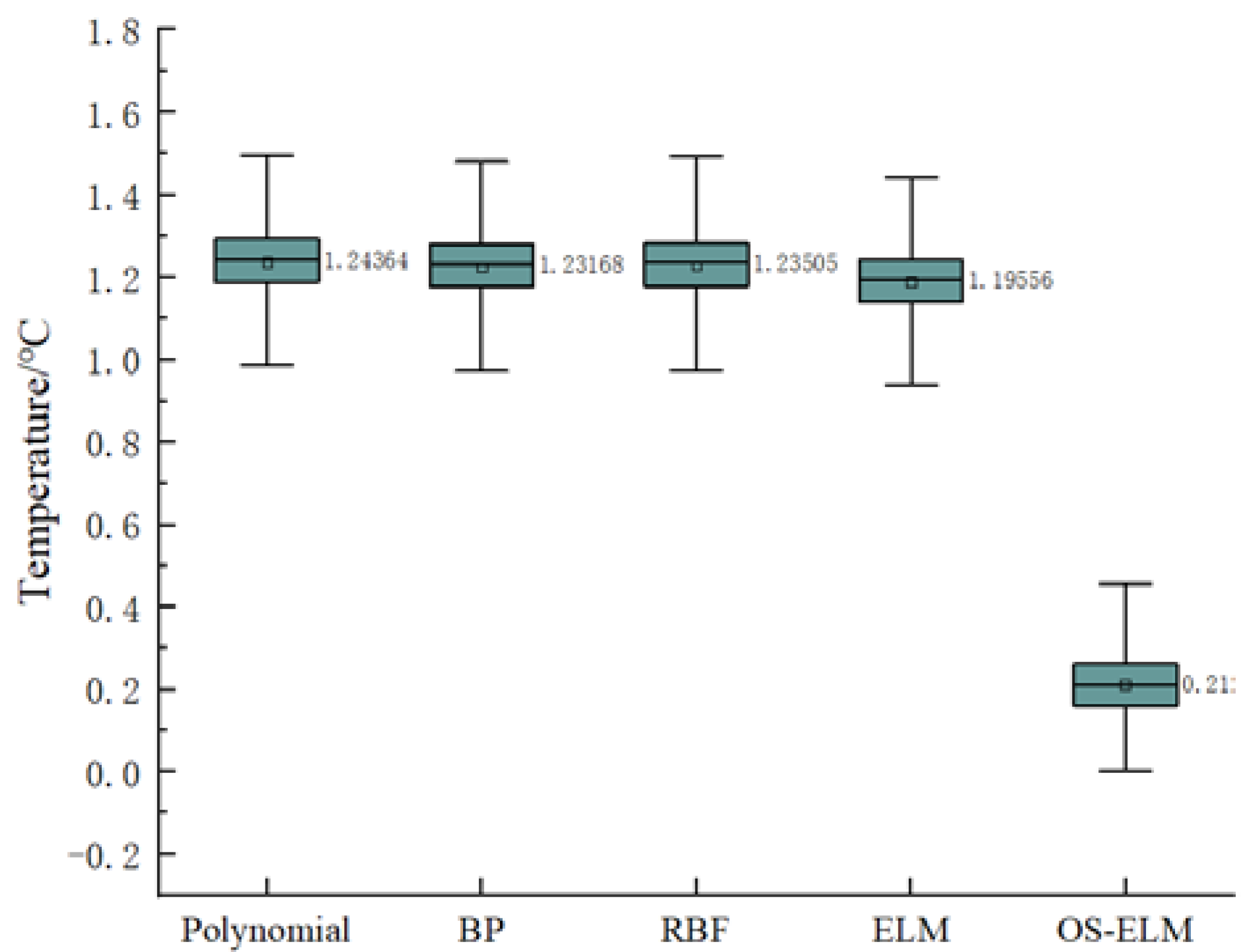
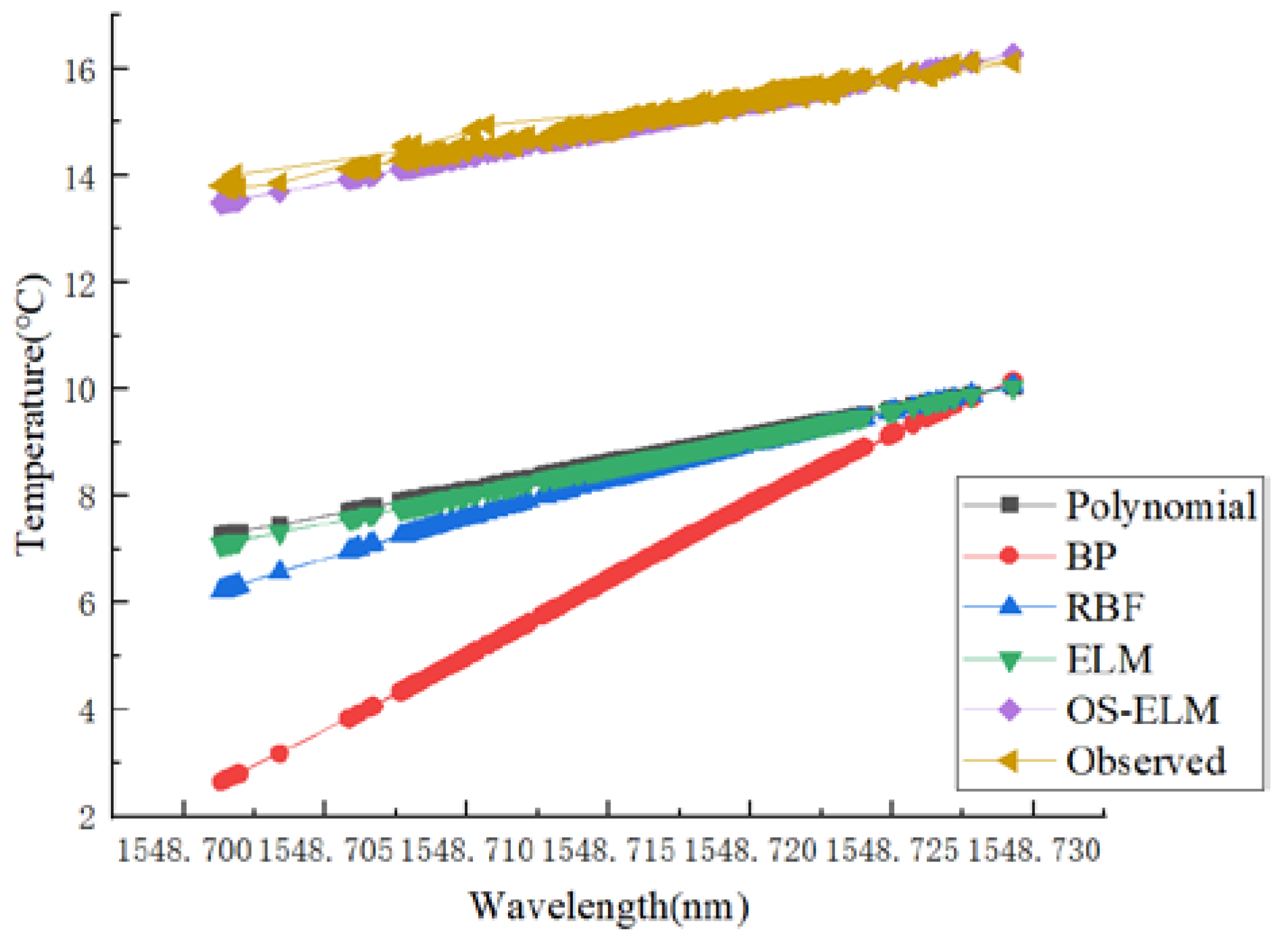
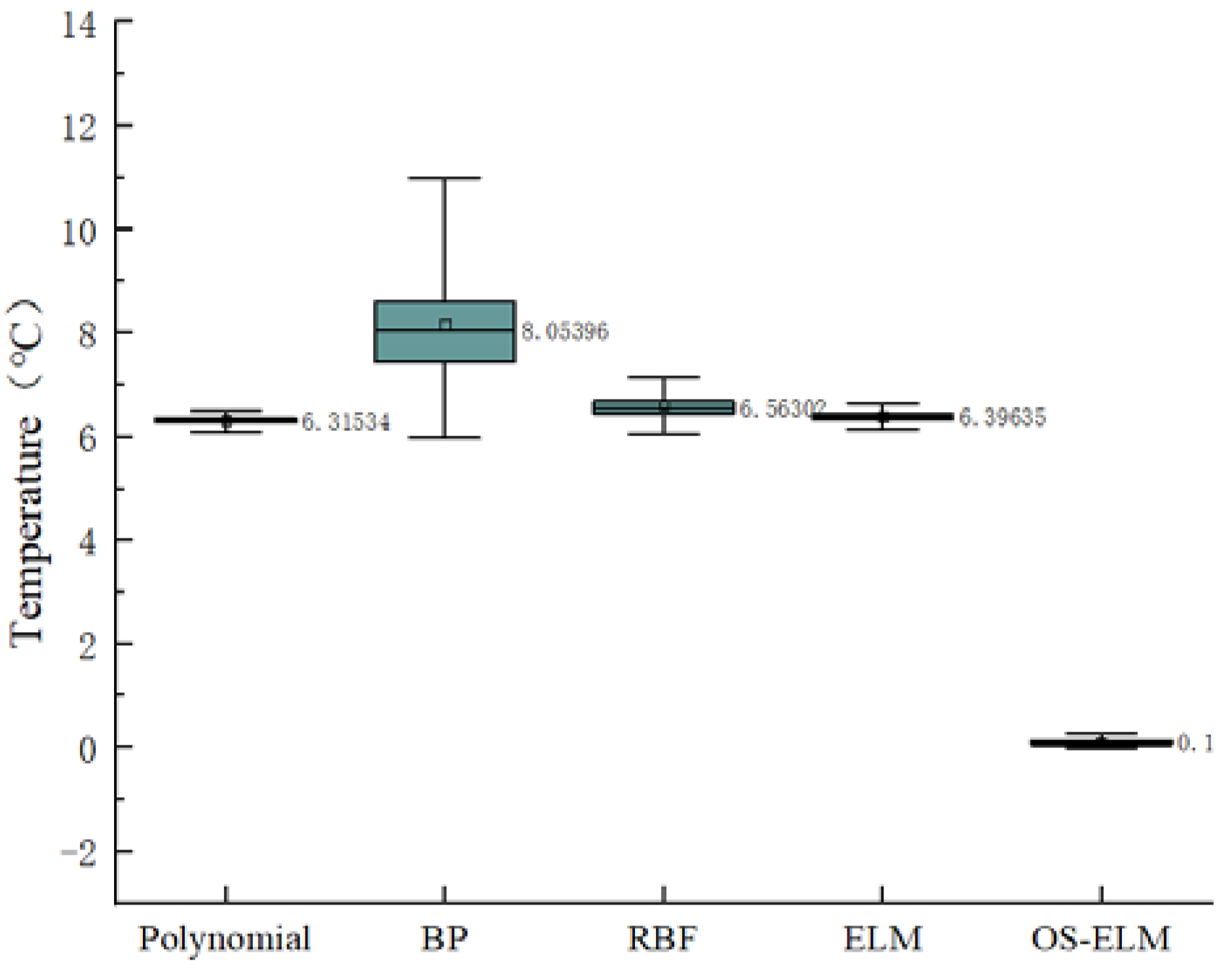
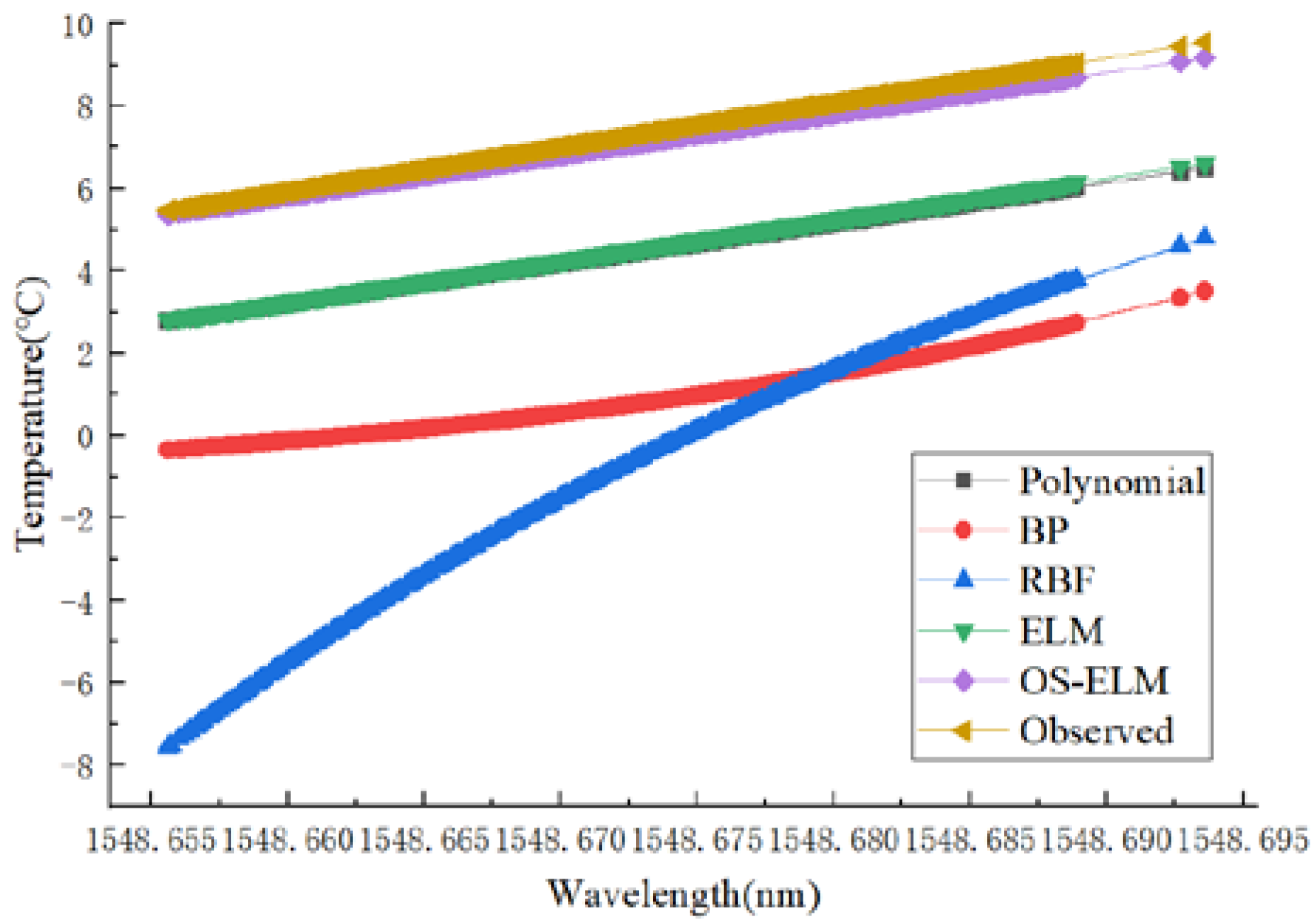

| Types of Activation Function | Time (s) | RMSE (°C) | ||||
|---|---|---|---|---|---|---|
| Training | Testing | Training | Testing | Training | Testing | |
| sig | 0.1094 | 0 | 0.0533 | 0.1027 | 0.9772 | 0.9698 |
| sin | 0.0154 | 0 | 0.0555 | 0.1803 | 0.9790 | 0.8983 |
| hardlim | 0.0156 | 0 | 0.3677 | 0.8426 | −5.5816 × 10−12 | 3.0073 × 10−13 |
| radbas | 0.0625 | 0 | 0.3774 | 0.8660 | 0.9772 | 0.9698 |
| Types of Calibration Model | Time (s) | RMSE (°C) | ||||
|---|---|---|---|---|---|---|
| Training | Testing | Training | Testing | Training | Testing | |
| Polynomial | 0.0156 | 0 | 0.0544 | 0.1327 | 0.9781 | 0.9686 |
| BP | 0.4063 | 0.0156 | 0.0535 | 0.1601 | 0.9789 | 0.9220 |
| RBF | 7.9688 | 0.0544 | 0.0625 | 0.1321 | 0.9781 | 0.9686 |
| ELM | 0.1094 | 0 | 0.0533 | 0.1027 | 0.9772 | 0.9698 |
| Types of Calibration Model | Time (s) | RMSE (°C) | ||||
|---|---|---|---|---|---|---|
| Training | Testing | Training | Testing | Training | Testing | |
| Polynomial | 0.0469 | 0 | 0.0764 | 0.0476 | 0.9120 | 0.9787 |
| BP | 0.4688 | 0 | 0.0799 | 0.1067 | 0.9052 | 0.8920 |
| RBF | 1.4844 | 0 | 0.0762 | 0.0467 | 0.9125 | 0.9819 |
| ELM | 0.0156 | 0 | 0.0762 | 0.0456 | 0.9125 | 0.9818 |
© 2020 by the authors. Licensee MDPI, Basel, Switzerland. This article is an open access article distributed under the terms and conditions of the Creative Commons Attribution (CC BY) license (http://creativecommons.org/licenses/by/4.0/).
Share and Cite
Shang, Q.; Qin, W. Fiber Bragg Grating Dynamic Calibration Based on Online Sequential Extreme Learning Machine. Sensors 2020, 20, 1840. https://doi.org/10.3390/s20071840
Shang Q, Qin W. Fiber Bragg Grating Dynamic Calibration Based on Online Sequential Extreme Learning Machine. Sensors. 2020; 20(7):1840. https://doi.org/10.3390/s20071840
Chicago/Turabian StyleShang, Qiufeng, and Wenjie Qin. 2020. "Fiber Bragg Grating Dynamic Calibration Based on Online Sequential Extreme Learning Machine" Sensors 20, no. 7: 1840. https://doi.org/10.3390/s20071840
APA StyleShang, Q., & Qin, W. (2020). Fiber Bragg Grating Dynamic Calibration Based on Online Sequential Extreme Learning Machine. Sensors, 20(7), 1840. https://doi.org/10.3390/s20071840




